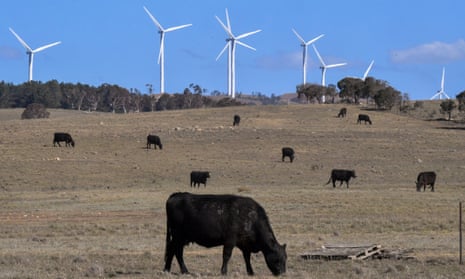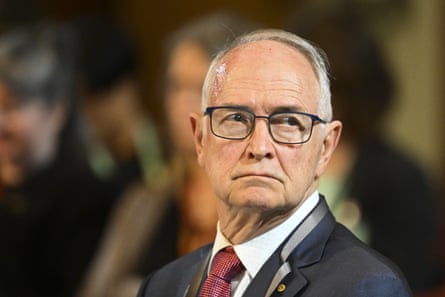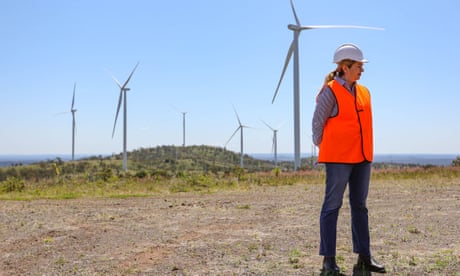Extract from The Guardian
The economist’s new book proposes an expanded Renewable Energy Target and an energy reserve system to ensure grid reliability.

Sun 2 Oct 2022 06.00 AEDT
Last modified on Sun 2 Oct 2022 06.02 AEDTAfter touring the then desiccated Murray-Darling Basin, Garnaut hailed the tumbling prices for renewable energy as offering a feasible path to cut carbon emissions and halt climate change without stalling the economy.
Not only were the economic winds shifting in Australia’s favour because of its abundance of wind and sun, so were political ones.
“If we are wise, we can change the political story of climate policy in this nation,” he wrote.
Less than three years on, “superpower” regularly surfaces in statements by state and territory ministers, and since May, by federal ones too. Cue, then, a new book, The Superpower Transformation, that Garnaut edited “after an electoral flood [that] has dug new channels for Australian political history”. (The rains returned too.)
“The book seeks to explain the coming challenge,” he tells Guardian Australia. “If we are to be pulling in the same direction, we need to know what that direction is, how far we’ve got to go, and the advantages of going there.”
We chat at the end of a big week for the energy transition off fossil fuels. Victoria’s monster new energy storage goals, Queensland’s accelerated decarbonisation plans and AGL’s faster exit from coal all jostled for headline billing.
That story, as Garnaut and other experts tapped for the new book highlight, is one of promise but also of peril. Since 2019, the prospect of “green steel” and other metals fired by hydrogen rather than coking coal has only enhanced Australia’s relative advantages as few nations boast both rich mineral and renewable energy wealth.
On the other hand, the early exit of big coal-fired generation assets poses challenges of its own. AGL alone is eyeing investments of $20bn to construct new solar and wind farms and back-up storage at a pace nobody is currently close to building.
The Australian Energy Market Operator identified “reliability gaps” for eastern mainland states from 2023-24 but a near-miss of major blackouts in June revealed the fragility of supplies. That’s even before AGL’s Liddell plant closes next April, with the country’s largest power plant, Origin’s 2,880-megawatt Eraring, following in 2025.
AEMO’s warning that $12.7bn needed to be spent on 10,000km of new transmission by 2050 to link up new renewable energy site is assessed closely in the book.
“There is a mammoth task for public policy in planning and implementing the reshaping of the transmission grid so that it is more aligned with the requirements of an electricity system dominated by renewable energy,” writes Dylan McConnell, another of the authors.
“You look at the lead times on these projects and the community consultation, and the planning and then the actual construction,” McConnell tells Guardian Australia. “These are going to take years and years to build.”
Moreover, he notes AEMO’s Integrated System Plan no longer contains scenarios that reflect existing policies.
Its so-called Step Change scenario, for instance, is deemed the “most likely” and is the central scenario used for planning purposes. It forecasts 83% of power in the national electricity market will be sourced by renewables by 2030-31, up from 32% in the June quarter of 2022, but is not yet backed by policies to get there.
“It’s like people expect things to happen,” McConnell, an honorary researcher at the University of Melbourne, says. Last week’s developments in Queensland and Victoria help bridge the gap between expectations and reality but he notes “there’s not actually a lot of policy underpinning them yet”.

The RET’s extension would provide additional incentives for new clean energy projects at no budget cost “through the crucial years immediately ahead”, Garnaut writes. Such schemes, though, would add costs to consumers in the near term while delivering lower power prices over time.
Still, Australians should not lose sight of the “immense opportunity” that awaits if the country not only decarbonises but provides the materials – and in the case of exported electricity and hydrogen – that enable our trading partners to do so too.
As a nation already exposed to extreme weather from heatwaves, floods and droughts, the damage from global heating should provide added incentive.
“Ours is the developed country that will be most damaged by climate change,” Garnaut writes. There’s “an overwhelming national interest” in the world meeting the agreed Paris goal of holding temperature increases to 1.5C.

No comments:
Post a Comment